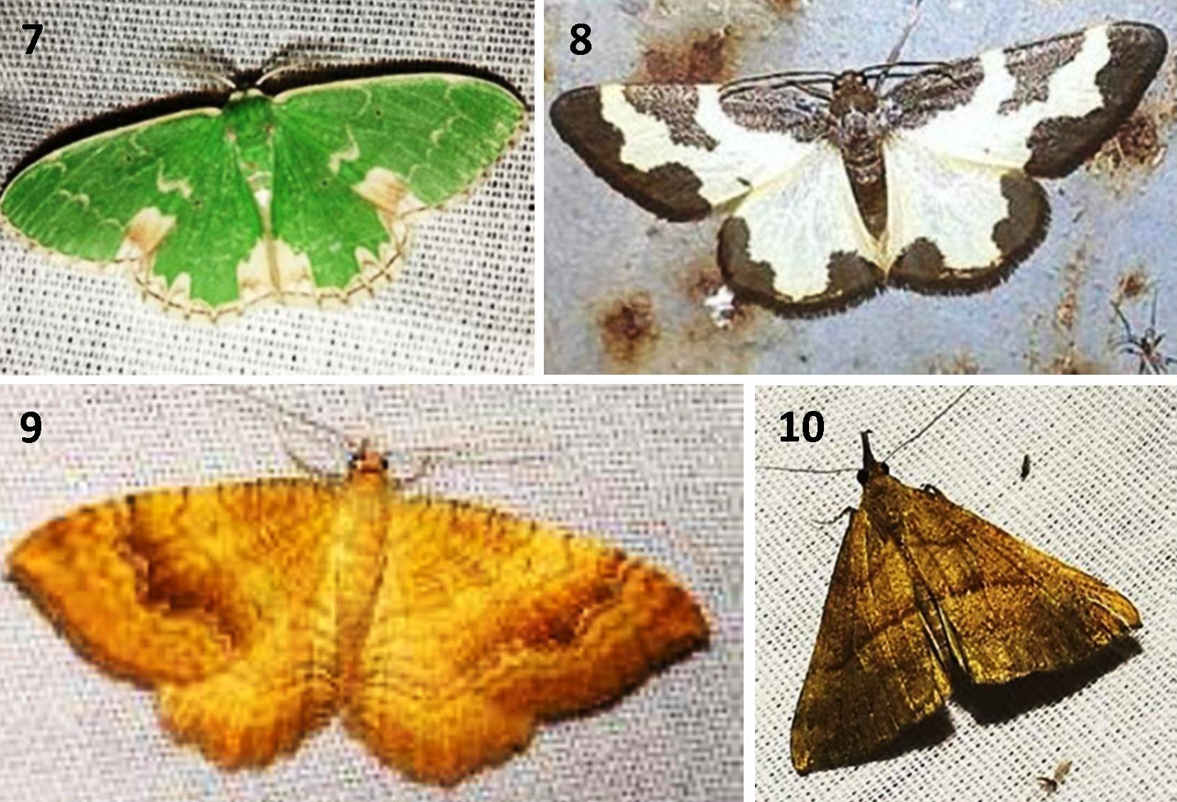Notes on occurrence of moths (Lepidoptera, Heterocera) in Ksany village in the commune of Opatowiec of the Świętokrzyskie Province
DOI:
https://doi.org/10.5604/01.3001.0014.4282Słowa kluczowe:
moths, nocturnal butterflies, Heterocera, Geometridae, Erebidae, rapid inventoryAbstrakt
On selected days from July to September 2017, the butterfly species with twilight and nocturnal activity in the village of Ksany in agriculturally and little anthropogenically transferred land were studied. Catching was done in the evening and night hours, using a method of the vividly attracting to the light. Flying moths were photographed on-site for later determination. A total of 13 catches were carried out with an average at intervals of 1-2 weeks. Over 60 moths species were determined, mostly belonging to the families Geometridae and Erebidae. When analyzing the results of catches, basic weather parameters such as temperature, air pressure and moon phase were taken into account.
Statystyka pobrań
Bibliografia
Buszko J, Masłowski J. Motyle dzienne Polski. Nowy Sącz: Koliber; 2015. Google Scholar
Buszko J, Masłowski J. Motyle nocne Polski Macrolepidoptera. Vol. 1. Nowy Sącz: Koliber; 2012 Google Scholar
Vaughan N. The diets of British bats (Chiroptera). Mammal Review. 1997;27:77– 94. https://doi.org/10.1111/j.1365-2907.1997.tb00373.x. Google Scholar
Wickramasinghe LP, Harris S, Jones G, Vaughan Jennings N. Abundance and species richness of nocturnal insects on organic and conventional farms: effects of agricultural intensification on bat foraging. Conservation Biology. 2004;18(5):1283–1292. https://doi.org/10.1111/wj.1523-1739.2004.00152.x. Google Scholar
Fox R, Parsons MS, Chapman JW, Woiwod IP, Warren MS, Brooks DR. (2013) The state of Britain’s larger moths 2013. Wareham, Dorset: Butterfly Conservation and Rothamsted Research; 2013. Google Scholar
Franzén M, Johannesson M. Predicting extinction risk of butterflies and moths (Macrolepidoptera) from distribution patterns and species characteristics. Journal of Insect Conservation. 2007;11:367–390. https://doi.org/10.1007/s10841-006-9053-6. Google Scholar
Groenendijk D, Ellis WN. The state of the Dutch larger moth fauna. Journal of Insect Conservation. 2011;15:95–101. https://doi.org/10.1007/s10841-010-9326-y. Google Scholar
Jonason D, Franzén M, Pettersson LB. Transient peak in moth diversity as a response to organic farming. Basic and Applied Ecology. 2013;14(6):515–522. https://doi.org/10.1016/ j.baae.2013.07.003. Google Scholar
Fayle TM, Sharp RE, Majerus MEN. The effect of moth trap type on catch size and composition in British Lepidoptera. British Journal of Entomology and Natural History. 2007;20(4):221–232. Google Scholar
Intachat J, Woiwod IP. Trap design for monitoring moth biodiversity in tropical rainforests. Bulletin of Entomological Research. 1999;89:153–163. Google Scholar
Brehm G. A new LED lamp for the collection of nocturnal Lepidoptera and a spectral comparison of light-trapping lamps. Nota Lepidopterologica 2017;40(1):87–108. https://doi.org/10.3897/nl.40.11887. Google Scholar
Infusino M, Brehm G, Di Marco C, Scalercio S. Assessing the efficiency of UV LEDs as light sources for sampling the diversity of macro-moths (Lepidoptera). European Journal of Entomology. 2017;114:25–33. https://doi.org/10.14411/eje.2017.004. Google Scholar
Butler L, Kondo V, Barrows E, M., Townsend EC. Effects of weather conditions and trap types on sampling for richness and abundance of forest macrolepidoptera. Environmental Entomology. 1999;28(5):795–811. https://doi.org/10.1093/ee/28.5.795. Google Scholar
Yela JL, Holyoak M. Effects of moonlight and meteorological factors on light and bait trap catches of noctuid moths (Lepidoptera: Noctuidae). Environmental Ento mology. 1997;26(6):1283–1290. https://doi.org/10.1093/ee/26.6.1283. Google Scholar
EASAC. A user’s guide to biodiversity indicators. London: European Academy of Science Advisory Council; 2004. Google Scholar
Amann G. (2009). Owady: kieszonkowy atlas najważniejszych chrząszczy, motyli i innych owadów lasów Europy Środkowej oraz ich stadiów rozwojowych i żerowisk, zawierający opisy poszczególnych gatunków. Warszawa: Multico Oficyna Wydawnicza; 2009. Google Scholar
Twardowski J, Twardowska K. Atlas motyli: 250 gatunków motyli. Warszawa: Wydawnictwo SBM; 2014. Google Scholar
Bellmann H. Atlas motyli: poradnik obserwatora. 2nd ed. Warszawa: Wydawnictwo RM; 2015. Google Scholar
Jonko Ch. Lepidoptera Mundi. 2020. Available at: https://lepidoptera.eu. Google Scholar
InfoMeteo.pl. Pogoda w Kazimierzy Wielkiej [weather forecast website]. Available at: http://kazimierza-wielka.infometeo.pl. Google Scholar
Timeanddate.com. Moon Phases 2020 – Lunar Calendar. Available at: https://www.timeanddate.com/moon/phases/. Google Scholar
Nowacki J, Pałka K. Noctuid moths (Lepidoptera: Noctuoidea: Nolidae, Erebidae, Noctuidae) of the Nowa Dęba Military Training Area in the Sandomierz primeval forest (south-eastern Poland). Fragmenta Faunistica. 2015;8(1):21–36. Google Scholar
Karpowicz S. Spis łuskoskrzydłych Ziemi Sandomierskiej II. Polskie Pismo Entomologiczne. 1928;7:93–122. Google Scholar
Kulesza W. Przyczynek do znajomości fauny motyli niektórych okolic Polski. Sprawozdania Komisji Fizjograficznej PAU. 1936;70:139–148. Google Scholar
Bielewicz M. (1973). Motyle Bieszczadów Zachodnich i Pogórza Przemyskiego. Cz. 1 tzw. Macrolepidoptera. Roczniki Muzeum Górnośląskiego w Bytomiu: Przyroda. 1973;7:1–170. Google Scholar
Bielewicz M. Nowe gatunki motyli większych (Macrolepidoptera) dla fauny Bieszczadów zachodnich i Pogórza Przemyskiego. Polskie Pismo Entomologiczne. 1984;54:407–409. Google Scholar
Heck KL, Van Belle G Jr, Simberloff D. Explicit calculation of the rarefaction diversity measurement and the determination of sufficient sample size. Ecology. 1975;6:1459–1461. https://doi.org/10.2307/1934716. Google Scholar
Raup DM. Taxonomic diversity estimation using rarefaction. Paleobiology. 1975;1(4):333–342. https://doi.org/10.1017/S0094837300002633. Google Scholar
Van Langevelde F, Ettema JA, Donners M, Wallis De Vries MF, Groenendijk D. Effect of spectral composition of artificial light on the attraction of moths. Biological Conservation. 2011;144(9):2274–2281. https://doi.org/10.1016/j.biocon.2011.06.004. Google Scholar

Pobrania
Opublikowane
Jak cytować
Numer
Dział
Licencja
Prawa autorskie (c) 2020 Państwowa Wyższa Szkoła Zawodowa w Tarnowie & Autorzy

Utwór dostępny jest na licencji Creative Commons Uznanie autorstwa – Użycie niekomercyjne 4.0 Międzynarodowe.



